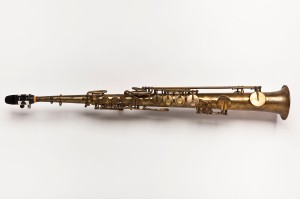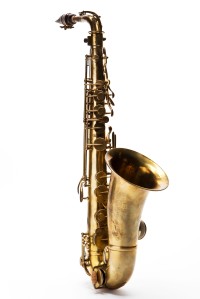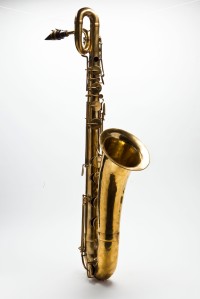Double set of saxophones, c1856-68, by Adolphe Sax, acquired by the University of Edinburgh Collection of Historic Musical Instruments in 2004 with an NFA grant of £29,000.

Soprano saxophone in B-flat, c1859. Photograph by Dominic Ibbotson reproduced by permission of the University of Edinburgh
Though the saxophone is instantly recognisable as a symbol of jazz and swing, its prolific creator Adolphe Sax could not have imagined such 20th-century music when he invented the instrument in the late 1830s. The bicentenary of Sax’s birth on 6 November 1814 at Dinant, Belgium, is being widely celebrated this year. He experimented with saxophone while working in his father’s musical instrument factory in Brussels; in 1842 he set up his own business in Paris where the work of developing and manufacturing the saxophone took place.

Alto saxophone in E-flat, c1856. Photograph by Dominic Ibbotson reproduced by permission of the University of Edinburgh
Of all Sax’s inventions, the saxophone was the most revolutionary and has been the most successful. The saxophone is the most important musical instrument to originate in a well-documented invention by a single innovator. The family of saxophones of different sizes was intended to provide a robust voice for military bands and they were used in wind bands, mainly in France but also in Britain and the USA. Emerging jazz and popular dance bands found the saxophone’s power and flexibility ideal.

Baritone saxophone in E-flat, c1860. Photograph by Dominic Ibbotson reproduced by permission of the University of Edinburgh
In 2004 the University of Edinburgh, supported by the National Fund for Acquisitions, the Pilgrim Trust, the Russell Trust and the Hope Scott Trust, purchased eight saxophones made in Sax’s workshop. Four of these, soprano, alto, tenor and baritone saxophones, were made between 1856 and 1860 and represent Sax’s early design; the other four, in the same sizes and made between 1862 and 1868, show how Sax subtly modified the proportions around 1861. The two quartets can be seen side-by-side in the Reid Concert Hall Museum of Instruments, Bristo Square, Edinburgh.
Prof Arnold Myers
Curator Emeritus
Musical Instrument Museums Edinburgh
